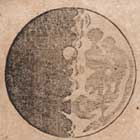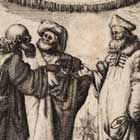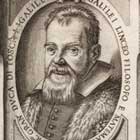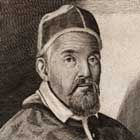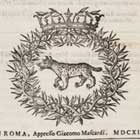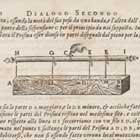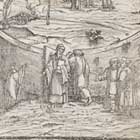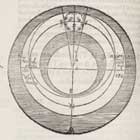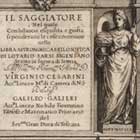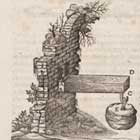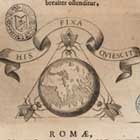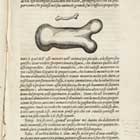JANUARY 2013
The Essay on BBC Radio 3
Andrew Brown's excellent Radio 3 essay on Galileo draws on Galileo: Watcher of the Skies (to listen click here).
OCTOBER 2010
Vittorio Frajese, Il processo a Galileo Galilei: Il falso e la sua prova (Morcelliana: Brescia, June 2010)
Professor Frajese has considerable expertise with regard to ecclesiastical censorship in the time of Galileo. His short book has two main arguments. The first is that Copernicanism was not formally condemned as a heresy in 1616, and that this was a substantial obstacle to convicting Galileo in 1633 – the first part of this argument is undoubtedly correct, and the second part is interesting, if not perhaps conclusive. The second argument is that close examination of the official record of Seghizzi's precept of 1616 shows that it was not the original expectation of the compiler of the record that he would be entering a text of this sort – the result was a botched entry, clearly written in two phases, probably in the wrong format, for which adequate space had not been provided. I find this argument entirely convincing. From it Frajese concludes that the precept is a forgery compiled in 1616. Is this right? The problem with it is that the forgery served no immediate purpose, and indeed it could not be used as long as Bellarmine was alive, as he would have known that it was false – and whoever made the forgery was putting themselves at some risk of being discovered. Can we construct an innocent explanation for the peculiarities of the documentary record as we find it? I think we can. All we need do is assume that the compiler of the record, Andrea de Pettini, heard that Galileo and Bellarmine had met; he will immediately have assumed that Bellarmine had give Galileo a “fraternal admonition” and Galileo had acquiesced; rather hastily he began to enter an official record. Seghizzi then arrived and said that matters had not gone smoothly, and the text of the precept then had to be squeezed in. Obviously this “innocent” explanation presents difficulties, but so does the hypothesis of a forgery made not (as has often been claimed) in 1632, but (as Karl von Gebler suggested in 1877) in 1616. I am not (at least not yet) convinced by Professor Frajese's argument, but it is a significant contribution to the literature. (As I write this I have received a copy of Galilaeana VII (2010) which contains articles by Sergio Pagano on the Frajese hypothesis (pp. 143-203) and by William Shea, replying (in English) to Gingerich's “Curious Case”, and defending Horst Bredekamp's Galileo der Künstler (pp. 97-110).
SEPTEMBER 2010
Forthcoming on Galileo:
Galileo Galilei and Christoph Scheiner, On Sunspots, ed. Eileen Reeves and Albert van Helden (Chicago, 2010).
John Heilbron, Galileo (Oxford, 2010).
David Wootton, “Galileo's Failures” in Causation and Modern Philosophy, ed. Keith Allen and Tom Stoneham (London: Routledge, 2011).
Debate:
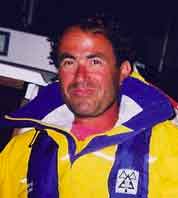 In a recent article in La Stampa (to download, click here) Mario Biagioli has maintained that Galileo probably lied when he claimed
not to have seen a telescope before he first made one of his own. No one disputes that Galileo knew that telescopes existed before he made
his own telescope -- they had been recently invented in Holland, and Galileo, in his first publication on the telescope, said he had heard about
them in a letter from France. The question is when the first telescope reached Galileo in Padua, or his friends, such as Paolo Sarpi, in Venice,
and whether it did so before or after Galileo made a telescope of his own (we know there was a Dutch telescope in Padua on 1 August 1609, and
that Galileo was offering to demonstrate his own telescope to the Venetian government on 24 August – if we are to believe Galileo we must assume
either that he already had a telescope of his own by 1 August, or that he was never shown the Dutch telescope when it first arrived). Biagioli now
claims that a letter of Sarpi's demonstrates that he had a telescope in his hands in Venice on 21 July, and that he almost certainly
showed it to Galileo, who then copied it, and lied about having done so.
In a recent article in La Stampa (to download, click here) Mario Biagioli has maintained that Galileo probably lied when he claimed
not to have seen a telescope before he first made one of his own. No one disputes that Galileo knew that telescopes existed before he made
his own telescope -- they had been recently invented in Holland, and Galileo, in his first publication on the telescope, said he had heard about
them in a letter from France. The question is when the first telescope reached Galileo in Padua, or his friends, such as Paolo Sarpi, in Venice,
and whether it did so before or after Galileo made a telescope of his own (we know there was a Dutch telescope in Padua on 1 August 1609, and
that Galileo was offering to demonstrate his own telescope to the Venetian government on 24 August – if we are to believe Galileo we must assume
either that he already had a telescope of his own by 1 August, or that he was never shown the Dutch telescope when it first arrived). Biagioli now
claims that a letter of Sarpi's demonstrates that he had a telescope in his hands in Venice on 21 July, and that he almost certainly
showed it to Galileo, who then copied it, and lied about having done so.
As the author of books on both Sarpi and Galileo I turned to Biagioli's article in La Stampa with great interest, assuming he had found a new letter from Sarpi about the telescope. But no -- this is a letter first published in 1833 (the text is here on p. 72), one which more recently appears in one of the standard editions of Sarpi's letters. Biagioli puzzles over why previous scholars (including Favaro and Sosio, both of whom were acquainted with it) have failed to acknowledge its significance. The answer is simple -- it does not say what he interprets it as saying. Sarpi's letter provides a round up of news from around the world -- Alexandria, Bohemia, etc. As for Italy, he says, there's no news -- except a telescope has arrived. He does not say it has arrived in Venice, only that it has arrived in Italy (my guess would be that he had heard a telescope had arrived in Rome – cf. OG x 260, Pignoria to Gualdo). He does not say he has seen it, only that he thinks the claims being made for it are exaggerated – he discusses its significance as a new military technology because the letter is concerned with geo-political developments. (Later in his letter Sarpi turns to events in Venice – but the discussion of the telescope is in the news round up section, not in the section where Sarpi discusses matters of which he has direct experience.)
It is not surprising that scholars have thought this letter irrelevant to any discussion of when the telescope first arrived in Venice or in Padua. It leaves us exactly where we were before: we have no new reason to doubt Galileo's claim that he independently reinvented the telescope. I recognize that Biagioli's reading of the letter is indeed possible, but in context it is less than probable, which is why scholars (myself included) looking for reliable evidence have put this letter to one side. He goes on to claim that his “discovery” shows that Galileo was an intellectual entrepreneur rather than a disinterested scientist. I've engaged with this view of Galileo extensively in my book.
In my book I say of Antonio Favaro: “Favaro was not an impartial scholar – nobody is. He laboured to defend Galileo’s reputation as a scientist, as a man, and as a pious Catholic; inconvenient details were buried, brushed aside, or put in the best possible light. But they were never suppressed.” If Biagioli is right this judgement is wrong: Favaro stands accused of omitting this letter from the Opere when he should have included it, and so of suppressing an inconvenient detail. I see no reason to revise my assessment of Favaro's scholarship.

